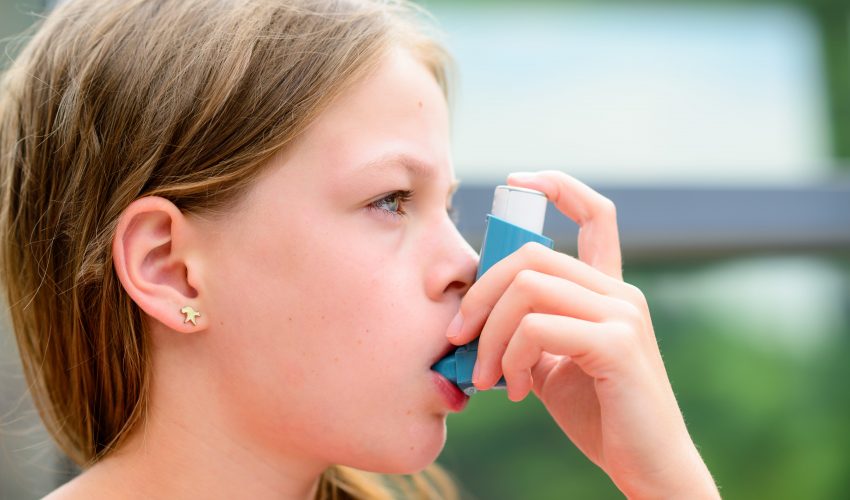Post Views: 8,306
ViewsAre There Benefits to Using a Spacer Device with a Pressurized Metered Dose Inhaler?
By Paul Watson RN DipHE, BA(Hons) SCPHN(SN),PSHE, PGCE, PGDip, QTLS
Abstract
This article has been produced to provide an understanding of the author’s area of study. It draws together, through the use of literature searches, personal experiences and previous studies, an understanding of asthma, and in particular the treatment of asthma with pressurised metered dose inhalers (pMDI). It demonstrates the need for the pMDI’s, and also highlights the health and cost benefits of using a pMDI through a spacer device. It then goes on to briefly demonstrate the benefits of a new style spacer, the POCKETFLOW, against two other models. Through the review and evaluation of other studies, this piece of work has been able to clearly demonstrate the importance of correct asthma management and the continued usage of spacer devices. Although it is recognised that there are many different types of spacer devices, and patients often still have less than optimal technique, with evidence from Keeley’s in vivo study in 1992, Lavorini and colleagues work in 2006, Fine JM and Clark JD’s review of the efficacy of spacers in 2007 and Khan and Chrystyn’s in-vitro dose emission study in 2009 supporting the overall benefits of use against non-use. With no empirical evidence produced to demonstrate improved clinical outcomes of spacer devices the author is left with one outstanding question, “Will the POCKETFLOW collapsible spacer deliver improved clinical outcomes for patients as compared to current spacer devices?”
Introduction
This article will be demonstrating through examination of literature and review of studies that the use of spacer devices is indicated or not, when using pressurised metered dose inhalers (pMDI). Inhalation has become the preferred route of administration for anti-asthma therapies, with this route, providing the drug in a form that can reach the smallest airways. Very small doses of active drugs can be presented to the desired site of action by allowing medication dosages to be kept low, and as the dose required is smaller than when given by mouth, side-effects are reduced (Asthma UK 2011, Lavorini et al 2006, Hindle & Chrystyn 1994). Unfortunately, poor technique frequently leads to reduced drug delivery to the patient, which Watt and colleagues detailing that in a study of 55 moderate to severe asthmatic children where only 73% had a technique that would allow any drug delivery (Watt et al 2003, Hindle & Chrystyn 1994, Pearce 2011). When compared to a 4mg tablet of salbutamol a single dose of inhaled medication contains 40 times less medication and yet delivers the same benefits, when taken correctly (Pearson, 1991, Watt et al 2003). The term “spacer devices” covers a range of inhalation aids of varying dimension and complexity, often known alternatively as “add-on devices”, “extension devices”, or “holding chambers” (Lavorini et al 2006). From now on, these devices will be referred to within this article as “Spacer”.
Spacers are large plastic or metal containers, with a mouthpiece or mask at one end and a hole for the aerosol inhaler at the other, although they only work with aerosol inhalers, and not breath actuated or powder inhalers (Watson 2010, Lavorini et al 2006). In patients, the effectiveness of nebulizers and metered-dose inhalers are enhanced with the use of spacers (Cohen et al 2012, Hindle & Chrystyn 1994) and currently most spacers are large and cumbersome, difficult to carry around and difficult for children to use (Health Enterprise East (HEE), 2009). Spacers do, however, have an important role to play in helping to deliver asthma medicine to the lungs and to ensure greater drug deposition; although O’Callaghan and Barry remind us in their work from 1997 that spacer size may also affect the amount of drug available for inhalation, but this will vary with the drug prescribed (Russell & Reynolds 1997). Spacers also make inhalers easier to use and reduce the risk of side effects. Pressurized metered dose inhalers (pMDI) are widely used for the long-term management of asthma (Watson 2010, Lavorini et al 2006, Health Enterprise East (HEE), 2009, Barry & O’Callaghan 1997), although not without some risks, as Cohen and colleagues detail in 2012 when they tested thirty spacers of children they were working with, all thirty were contaminated with pathogens as Pseudomonas, Klebsiella and Staphylococcus, with four of these patients later contracting pneumonia. Once Cohen and colleagues educated the spacer users in the art of correct cleaning of spacers and masks the incidents of contaminated spacers and masks fell to zero percent (Cohen et al 2012).
The POCKETFLOW spacer has been designed by the author of this article and its technical qualities have been tested; with these being assessed against other spacers, and detailed later in this article.
Why look at asthma? What’s going on?
According to Asthma UK, more than 1 million sufferers of asthma in the UK are children, with asthma being the most frequent reason for absence from school, accounting for one-third of all days of missed instruction (Krenitsky-Korn 2011). There were 1,131 deaths from asthma in the UK in 2009 (12 were children aged 14 years or under), with an estimated 75% of hospital admissions for asthma being avoidable and as many as 90% of the deaths from asthma being preventable (Asthma UK, 2011). Although asthma will often start in childhood, it can happen for the first time at any age, even in people in their 70s or 80s (Asthma UK, 2011, British Lung Foundation 2011). The British Thoracic Society (BTS) recommends that asthma is managed in children aged 0–5 years by use of a pressurized metered dose inhaler (pMDI) and a spacer device for the delivery of inhaled steroids (BTS 2009 and Scottish Intercollegiate Guidelines Network (SIGN), 2009).
The cause of asthma is still not fully understood, but it is thought that it may be a combination of genetic and environmental factors. Asthma often runs in families and you can inherit the susceptibility to asthma, which is then triggered by certain environmental factors, with some asthma sufferers having certain allergies. In these people, airway inflammation occurs because they are exposed to items in their environment to which they are allergic, for example house dust mites, cat and dog hair. This is known as atopic or allergic asthma. Other people with asthma have no such allergies and the cause of their airway inflammation is unclear (known as non-atopic asthma) (Asthma UK, 2011, British Lung Foundation 2011).
In both types of asthma, the inflamed air passages can be irritated by lots of ‘triggers’, these triggers cause the airways to narrow, which results in an asthma attack and include:
- Viruses
- Exercise
- Cold air
- Emotion
- Pollution
- Cigarette smoke
- Substances in the workplace (Asthma UK, 2011, British Lung Foundation 2011, White N 2012).
For those with allergic asthma, exposure to items to which the person is allergic can trigger an asthma attack, these causes are also known as allergens. However, allergens do not trigger asthma attacks in people with non-atopic asthma, for which the cause is often unknown (Asthma UK, 2011, British Lung Foundation 2011, White N 2012).
Justifying the need to review current processes.
Having observed poor techniques when using standard spacers, and seen how cumbersome and awkward they can be, it was decided to investigate the benefits of inhaler usage through a spacer device compared to direct inhalation, with a further consideration then being given to the benefits of each spacer device, as compared to each other. Studies suggest the prevalence of diagnosed asthma is between 10 and 20% in England & Wales whilst it is estimated that Chronic Obstructive Pulmonary Disease (COPD) is prevalent in 4% of the populations of the USA, Europe and Japan. The majority of asthma & COPD inhaler medication is delivered by press-and-breathe pMDIs (HEE 2009) and it is estimated that at least 50% of pMDI users have less than optimal technique and could benefit from using a spacer device ( Lavorini et al 2006, HEE 2009, Pearce 2011). The most detrimental errors are the poor coordination between the pMDI actuation and the inhalation, and the so-called “Cold Freon” effect, which may cause some patients to stop inhaling completely when the cold blast of propellant strikes the back of the throat. As a result of this process the take up of medication is vastly reduced (Lavorini et al 2006).
Lavorini and colleagues were able to demonstrate in their paper that the addition of a spacer device to the pMDI not only markedly reduced the incidence of oral candidiasis but also resulted in a continuing trend of improvement in airflow obstruction over three to six months, although this was not evident in patients who were using the pMDI alone (Lavorini et al 2006). As this article forms its conclusion it will have drawn together the findings of the literature review and contrasted that against the unpublished findings. The article will have been able to demonstrate the benefits, if they exist, of particular spacer devices when compared to using the pMDI on its own.
Large volume spacers can be cumbersome and it was for this reason that the author wants to investigate the usage of a more portable spacer device against the current spacers in production, a study very similar to that of Shultz and colleagues in 2012 where they compared the “Funhaler” to other devices. Shultz reports that spacer technique is often suboptimal in children with asthma, with the overall delivery of medication influenced by the patients’ proficiency in using them (Schultz et al 2012). The aim of this article is to investigate and highlight the benefits of using spacer devices when using pMDIs, if in fact that is the case. This will be done by looking at pMDI usage on its own and through three spacer devices and reviewing the collected data to assess if there are any significant benefits to the patient.
Why is asthma a problem?
Asthma affects the airways of the lungs (the bronchi) which causes the airways to become inflamed and swollen. It is a chronic lung disease that causes sufferers to have repeated attacks of:
- Coughing
- Wheezing
- Chest tightness
- Breathlessness. (Watson P 2010, Lavorini et al 2006, Health Enterprise East (HEE), 2009).
Many asthmatics have few symptoms between attacks, but some sufferers have severe asthma and suffer from symptoms all the time (chronic severe asthma).
In people with asthma, the linings of the air passages (bronchi and bronchioles) are inflamed and become irritated, they narrow, the muscles around them tighten, and there may be an increase in the production of sticky mucus, or phlegm. This reaction makes breathing difficult, the chest may feel tight, and the sufferer may experience wheezing and coughing (Clinical Knowledge Summaries (CKS) 2009, Watson 2010, Lavorini et al 2006).
For asthma sufferers, the bronchi are more sensitive than normal and certain substances, or triggers, can irritate them. The severity of the symptoms of asthma differs from person to person over time, from mild to severe, with the narrowing of the airways usually being reversible – occurring naturally, or in response to the use of medication (Asthma UK, CKS 2009).
It is good practice that sufferers of asthma have an inhaler that was prescribed to them in case of an attack; one type of inhaler contains medicines that are taken immediately to relieve the asthma symptoms, called relievers and long-term treatment called preventers (Asthma UK 2011). There are various types of drugs that could be prescribed to the sufferer, but for the purpose of this article, we will be concentrating on the use of the pMDI as a delivery system, as opposed to the medication that is being delivered.
At present asthma is not curable, but it can be controlled so that attacks can be prevented (British Lung Foundation 2011). Asthma is a chronic (long-lasting) inflammatory disease of the airways. Statistically asthma in children is more common among boys than girls (CKS 2009), although fortunately for many children Asthma UK (2011) report that those children who develop asthma at a very young age are more likely to ‘grow out’ of the condition as they get older. The Clinical Knowledge Summaries (CKS) produced by the NHS (2009) informs us that during the teenage years, the symptoms of asthma will disappear in approximately three-quarters of all children with the condition, however, asthma can return in adulthood. If during childhood the symptoms of asthma are moderate to severe, it is more likely that the condition will return later in life (CKS 2009, British Lung Foundation 2011).
In response to the inflammation, the muscles surrounding the airways begin to contract, making the airways constrict and narrow. The combination of the excess mucus and the inflammation and constriction of the airways makes respiration difficult. This results in the wheezing and coughing that is associated with asthma (CKS, 2009, British Lung Foundation 2011). Treatment for children with asthma should be a prescribed inhaler, possibly in the form of a Pressurised Metered Dose Inhaler (pMDI). Often the child will have a preventer (a pMDI used regularly to prevent the symptoms occurring) and a reliever (a pMDI used when necessary to reduce the symptoms of an exacerbation). Unfortunately, younger patients or patients with poor dexterity are often unable to coordinate inhalation with activation of the inhaler, thereby limiting the amount of drug inhaled (Watson 2010, Delgado et al 2007, Russell & Reynolds, 1997). It is for this reason that the introduction of spacer devices has helped to overcome this issue. Spacer devices allow the medication to be held in the chamber and the patient to receive inhaled medications whilst taking normal breaths through the mouth piece.
What do we need to know to improve practice?
Pressurized metered dose inhalers (pMDI) are widely used for the long-term management of asthma. However, there are a number of problems associated with their use:
- Amount of drug delivered to the lower airway can be limited by the size of the particles produced
- Problems with lack of co-ordination between actuation and dose inhalation
- Adverse effects including oral candidiasis and dysphonia may occur (CKS 2009, Watson 2010, HEE 2009).
When aerosol inhalers are prescribed it is usually good policy to have been given a spacer device at the same time as the pMDIs are much more effective and easy to use when used with a spacer device. The British Thoracic Society recommended in their latest guidelines that in children aged 0-5 years, pMDI and spacer should be used as the preferred method of delivery of inhaled steroids and a face mask be used where necessary (BTS 2009)
Often spacer devices are large and cumbersome, difficult to carry around and difficult for children to use, sometimes making them feel very confined or claustrophobic (HEE 2009). Many patients using pMDI’s with a spacer device still have to be trained to inhale slowly (< 30 Ltrs/ min)(Lavorini et al 2006) and to hold their breath after aerosol inhalation for at least 10 seconds. It is also important to be aware that a too long delay in inhalation after pMDI actuation may also lead to excessive loss of the respirable dose within the device (Lavorini et al 2006, O’Callaghan C Barry P 2000b).
Another thing to be aware of when using a spacer device is the discharging of multiple doses into the spacer at the same time. This can result in a lower inhalation of medication due to the turbulence in the spacer leading to a coalescence of small particles into larger particles, and excessive deposition on to the spacer walls, often reducing the respirable dose per actuation (Lavorini et al 2006, Khan & Chrystyn 2011, Hindle & Chrystyn 1994). Pearson details in his book “Asthma: Management in Primary Care” that it is acceptable practice to “discharge one or several puffs” (Pearson, p95 1991) into the chamber at the same time, without him giving consideration to the effect of coalescence of the smaller particles into large particles. This could be explained by the early nature of this publication, as this appears to now be an accepted fact, with many studies such as Keeley’s in vivo study in 1992, Lavorini et al work in 2006 and Khan and Chrystyn’s in-vitro dose emission study in 2009 supporting the coalescence effect.
Spacers have an important role to play in helping to deliver asthma medicine to the lungs, helping to ensure a more even drug deposition than when medication is used without. They also make inhaler use easier and reduce the risk of side effects (CKS 2009, Watson 2010, HEE 2009). By using the inhaler through a spacer the operator does not have to coordinate the delivery of the medication with an often difficult inhalation, therefore making the procedure more effective by getting more medicine into the lungs than when just using the inhaler on its own. Modern spacer devices are convenient and compact and work at least as well as nebulisers at treating most asthma attacks in children and adults (Parkin et al 1995, Dewar et al 1999, Delgado et al 2007).
With their correct and continued-use they help to reduce the possibility of side effects from the higher doses of preventer medicines by reducing the amount of medicine that is swallowed and absorbed into the body (Asthma UK 2009). Unfortunately, large volume spacer devices, introduced to overcome the problems associated with inhaled medication can themselves create problems, such as the need to remember to take this bulky item everywhere and the potential embarrassment of using it (CKS 2009, Watson 2010, HEE 2009).
Spacers reduce the need for patients to coordinate inhalation with actuation of the pMDI, but to best maximize the drug delivery period inhalation should start as soon as possible, after actuation of the inhaler. O’Callaghan and Barry suggest that if a health professional or carer is actuating the inhaler for the patient that this should be done only when the patient is ready and the spacer in place, as a time delay between actuation and inhalation can result in a reduced intake of medication (O’Callaghan C, Barry P, 1997).
Who is this article hoping to benefit?
This article is reviewing the current literature that has been published around the topic of Asthma and Spacer devices. In doing so, the author is able to establish with confidence what, if any, are the benefits to the patient of inhaled medication when used through a Spacer device, compared to the use of a pMDI alone. This outcome will in-turn provide the evidence for best practice and the improved prescription and usage of spacer devices amongst pMDI users. Whilst it is recognized widely that there are benefits to children using spacer devices this article will investigate that belief, and examine the benefits of correct inhaler technique with relevance to all users of pMDI’s, either with Spacers or not. The magnitude of the issue that this article is looking at is considerable with much data being provided to support the use of correct treatments (See Appendix 1).
What is already known, and are there any gaps in this knowledge?
Although there are lots of studies and reports that demonstrate the benefit/ comparison between spacer device and nebulised drugs, there are very few that demonstrate primary evidence of the benefits of spacer device against pMDI alone. Many of these reports document the benefits of spacer usage against non-usage but very few make reference to their source for these statements. Fortunately, during the literature review, the author was able to find several authors such as Keeley in 1992, Lavorini et al and Khan and Chrystyn in 2009 who have the primary research to be able to support these claims, therefore validating many comments in others work.
Spacers have an important role to play in helping to deliver asthma medicine to the lungs, helping to ensure greater drug deposition, also making inhalers easier to use and reducing the risk of side effects, and as such pressurized metered dose inhalers (pMDI) are widely used for the long-term management of asthma (Asthma UK 2011, CKS 2009, Watson 2010, HEE 2009).
When used with a spacer device the inhaler is discharged into the chamber and then the user breaths in through the spacer. This allows the user to take a deep breath and avoid the cold gases hitting the back of the throat and mouth as well as the difficulty of coordinating the release of gas and breathing in. By using the inhaler through a spacer the child does not have to coordinate the delivery of the medication with an often difficult inhalation (Asthma UK, 2011 Watson 2010). This results in a more effective procedure by getting more medicine into the lungs than when the inhaler is used on its own (Khan & Chrystyn 2009, Lavorini et al 2006, Keeley 1992). With their correct and continued use spacer devices help to reduce the possibility of side effects from the higher doses of preventer or the incorrect use of reliever medicines such as Salbutamol or Becotide by reducing the amount of medicine that is swallowed and systematically absorbed (Asthma UK, 2011, CKS 2009, HEE 2009).
What do we already know?
Correct inhaler technique could potentially result in a decreased rate of hospital admissions owing to asthma exacerbations. It is well known at this time of austerity that too many people with asthma spend time in hospital when they shouldn’t have to, with 75% of hospital admissions being able to be avoided (HEE 2009, Asthma UK 2011). If asthma is under control, sufferers are more likely to have a better quality of life and be more able to do the things they want to (Asthma UK 2011, CKS 2009, HEE 2009), not to mention the cost savings to the NHS, due to reduced medication usage and hospital admissions (HEE 2009, O’Callaghan C, Barry P 1997).
Keeley wrote a short paper in 1992 where he detailed the benefits of spacer usage, noting that the failure to treat asthma as well as we could is often a direct result of poor inhaler technique, with Agertoft and Pedersen supporting this in their work in 1994, where they were looking at the influences of spacer devices. Keeley goes on to explain his in vivo radiotracer study that showed that a large volume spacer deposited 21% of the dose in the lungs of the user with 16% being deposited in the oropharynx, and 56% being deposited in the spacer device, although Agertoft and Pedersen used a simple filter over the mouth piece in their study (Agertoft L, Pedersen S 1994). Keeley compared his findings to the pMDI alone and found that the results for this were that only 10-15% of the inhaled medication was deposited into the lungs with 70-80% being deposited in the oropharynx (It is not clear what happened to the remaining %’s) (Keeley 1992).
In 1993 Keeley published another paper supporting these findings and explaining that when compared with other inhalers the large volume spacers deposit at least 30% more drug in the lung and deposit 60% less drug in the patient because of reduced oropharyngeal deposition (Keeley 1993). Lavorini and colleagues also document the benefits of spacer usage and attribute the beneficial results to the fact that the patient is inhaling from a static volume without necessarily having to coordinate the two actions, of breathing and actuation.
And as such they draw the conclusion that by acting as an aerosol reservoir the spacer devices slow the aerosol velocity and increase transit time and distance between the pMDI and the patient’s mouth, therefore allowing the particle size to decrease, with Barry and O’Callaghan documenting that the ideal particle size for drug delivery to the lungs should be smaller than 5 um (Barry & O’Callaghan 1997). Lavorini also documented that as a result of this smaller particle size there is better lung deposition owing to the fact that the larger particles remain in the spacer and do not get deposited in the oropharynx, thereby supporting the evidence produced by Keeley and Khan and Chrystyn, with Khan and Chrystyn’s work being seen in Table 1(below).
It is clear to see therefore, that spacers reduce the impaction of the emitted dose in the oropharyngeal area and also improve lung deposition and Khan and Chrystyn give the same explanation for this as Lavorini and colleagues in 2006; believing that this is because the patient inhales from a static cloud from a spacer device compared to a very fast emitted dose from a pMDI. This results in reduction of oropharyngeal deposition with spacer devices, due to the large particles from the emitted dose being left in the spacer. It is important to be aware that not all the particles emitted from pMDI inhaler have the potential to be deposited into the lungs. These larger particles are too big to be deposited in the lungs, settling in the spacer device or in the back of the throat in the case of a pMDI used on its own.
The particles that are fine enough to be deposited in the lungs are known as the fine particle dose (FPD) and indicate the potential of the dose to be deposited into the lungs. Theoretically the higher the FPD then the greater the lung deposition and the greater the benefits to the patient (Khan and Chrystyn 2009, Keeley 1992). Each dose from an inhaler is emitted with a distribution of particle sizes and density. When measuring the characteristics of the emitted dose Khan and Chrystyn assessed another parameter that identified the potential of the dose to be deposited into the lungs. This is described as the mass median aerodynamic diameter (MMAD) and is defined as the particle size corresponding to half the emitted dose.
As it happens the results of Khan and Chrystyn’s work shows that the MMAD remains almost identical for pMDIs used through a spacer device against those used with a pMDI on its own. This finding is supported in the work of Zar H and colleagues where as a result of their study they too detail very little difference in the benefits of different spacers to patient improvement (Zar HJ et al 1999). There was, however, a marked difference in the spread of the particle size distribution, known as the geometric size distribution (GSD). The GSD is an indicator of the spread of the distribution of particles with values of less than 1.2 indicating a homogenous particle size distribution.
Most inhaled products have a GSD value of about 2 (Khan and Chrystyn, 2009), so a result of less than two would be a favourable one. Khan and Chrystyn’s work has shown that the use of a pMDI on its own has a GSD of 2.7 compared to 2.1 and 1.7 for the two most commonly used spacer devices and the POCKETFLOW producing a very impressive 1.6 (MDI+COLin Table 1), clearly demonstrating the benefits to the patient of using a spacer device, and in turn savings to the NHS.
In 1997 O’Callaghan and Barry reported that maximising drug output from spacers may improve therapeutic responses and reduce costs. They claimed that, at that time, much of the available information about spacers was coming from laboratory studies, in which the drug was collected on filters or in particle sizing apparatus. In 2009 Khan and Chrystyn dispensed with the filters and instead the aerodynamic characteristics of the dose emitted from a pMDI was determined using the Andersen Cascade Impactor (ACI). However, according to Labautomate the ACI greatly suffers from low productivity, typically two to four dose determinations per day and from operator induced data variability.
It was for this reason then that the Next Generation Impactor or the NGI was invented to overcome the low productivity issues experienced by the Andersen Cascade Impactor. Traditionally it was thought that the ACI was impossible to automate, with many companies switching to the NGI, as more and more people have begun using it, they too have experienced issues with it, demonstrating, therefore, that this is not the answer that most people thought it would be, and as a result the data produced with the ACI is acceptable and valid (Labautomate 2012).
The ACI was the impactor of choice, and to date almost all of the particle size distribution data submitted has been obtained using the ACI. Particle sizes in the 1 to 5 micron range penetrate deep into the lungs, permitting ready absorption of the drug into the blood, and thus are most efficacious (Labautomate 2012, Khan and Chrystyn 2009). An ACI consists of a cascade of discs stacked, one on top of each other and sealed from the environment.
Vacuum is applied and a constant airflow set up through the ACI. The inhaler is attached to the glass throat on top of the impactor and the drug is inhaled by the impactor. Drug particles of differing particle size get deposited on to different discs, with the bigger particles on the top and smaller particles on the bottom. After drug injection, the 22 components of the ACI must be disassembled in a clean room, and each of its components washed, weighed, dried and samples are collected in duplicate from each disc to determine the drug content. Assuming mass balance, the particle size is deduced from the layer it was collected and the particle size distribution for the dose is drawn up. The data from each process step has to be accurately recorded (Labautomate 2012, Khan and Chrystyn 2009).
Two separate 100 mcg doses were discharged into the ACI while it was operated at 28.3 l min-1 drawing an inhalation volume of 2 l. The method is described above and in more detail in the British Pharmacopoeia (2005), except that a 2 litre inhalation volume was used as opposed to 4 litres. Particle analysis was completed using Copley Inhaler Testing Data Analysis Software (CITDAS) (Khan and Chrystyn 2009). CITDAS took the data that was provided by the ACI and was able to calculate the fine particle dose values along with the other results required to complete Khan and Chrystyn’s findings. This testing was able to demonstrate that the fine particle dose was higher for the spacer devices over a pMDI alone, suggesting that lung deposition could be better than pMDI’s without spacer devices.
Evaluating current spacer efficacy
Designed by the author the POCKETFLOW spacer is a pocket-sized spacer which has been developed to overcome the issues associated with other more cumbersome spacers. It has been designed to provide patients with a device that can really meet their needs, being functional, portable and attractive. The volume and shape of the spacer has been designed and tested through extensive computer modelling and evaluation, to ensure optimal fluid flow through the chamber, resulting in far more efficient filling and emptying cycles than those seen in other models. The POCKETFLOW is compact and portable, (measuring only 105 mm in length when opened and 30.5 mm when collapsed, with a maximum diameter of 57 mm and an approximate volume of 150 ml, compared to 750 ml for the Volumatic Chamber). It can be carried easily in a pocket or a small hand bag (HEE 2009). The POCKETFLOW required testing and the results contrasting to those of current spacers. This testing was completed by Khan and Crystin in 2009 alongside the Volumatic, the AeroChamber Plus and the pMDI on its own.
The aerodynamic dose emission characteristics of two 100 mcg doses of salbutamol from a Ventolin pMDI (GlaxoSmithKline, UK) have been determined as follows (Khan and Crystin,
2009):
- pMDI alone [pMDI]
- pMDI attached to a Volumatic (GlaxoSmithKline) spacer [pMDI+VOL]
- pMDI attached to an AeroChamber Plus (Truddell International, Canada) spacer [pMDI+AERO]
- pMDI attached to a new novel collapsible spacer [pMDI+COL].(POCKETFLOW)
Table 1: Mean Summary of the aerodynamic dose emission characteristics of two 100mg Salbutamol doses from a Ventolin MDI (Khan and Crystin,2009).
| MDI alone | MDI + VOL | MDI + AERO | MDI + COL POCKETFOW | |
| TED (mg) | 180.26 | 190.35 | 169.58 | 184.01 |
| TED (% of normal dose) | 93.13 | 95.17 | 84.79 | 92.00 |
| Spacer | — | 121.88 | 111.44 | 114.19 |
| Dose ex mouth piece | 180.26 | 68.47 | 58.14 | 69.82 |
| FPD (mg) | 48.84 | 36.68 | 44.39 | 53.02 |
| FPD (% of nominal) | 24.42 | 19.34 | 24.66 | 26.51 |
| MMAD (mm) | 2.7 | 2.8 | 2.6 | 2.5 |
| GSD | 2.7 | 2.1 | 1.7 | 1.6 |
As detailed earlier in this piece it must be remembered that not all the particles emitted from an inhaler have the potential to be deposited into the lungs. Some of these particles are too big and this cut-off is known as the fine particle dose (FPD) and gives an indication of the potential of the dose to be deposited into the lungs. From Table 1 above, you can see that where the FPD is higher this represents a better lung deposition. By looking at Table 1 it becomes evident that whilst two spacer devices are producing a higher FPD one of the spacer devices is actually producing a lower spread than the pMDI alone. From Table 1 you can also see the mass median aerodynamic diameter (MMAD), this is the particle size corresponding to half of the emitted dose and is very similar for all 4 variations tested.
The overall spread of the particle size distribution is now the geometric size distribution (GSD) and gives an indication on the spread of the distribution. A GSD of less than 1.2 indicates a homogenous particle size with most inhaled products usually having a value of about 2. It is clear from table 1 that the GSD is better from the spacer devices than with the pMDI alone, and the POCKETFLOW spacer has the best GSD out of the spacers with the Volumatic not producing much better results than the pMDI on its own. The total emitted dose (TED) is the amount exiting the mouthpiece of the pMDI or the spacer, where there is a low TED this is an indication that the larger particles that would normally get stuck in the oropharynx are remaining in the spacer device. Lavorini and colleagues describe this as being a size-selective function, retaining larger particles on the spacer walls and allowing the smaller particles to pass through to the patient (Lavorini et al 2006). It is however recognised that although this could be as a result of the spacer design; providing a static cloud of medication before inhalation, resulting in the larger, heavier particles falling out of the way; it could also be as a result of static charge causing them to stick to the spacer walls. Static electricity accumulates on many polycarbonate and plastic spacers, especially when handled by the patient. This results in an attraction of drug particles, which then become charged when they are produced by the pMDI. A simple way to reduce the charge on a spacer device is to wash it, allowing it to air dry to avoid build up of static with a drying cloth (Khan & Chrystyn 2009, O’Callaghan C 1997, Lavorini et al 2006).
Due to the nature of different spacer devices and the care that they are given by their users their actual drug output may vary greatly. Drug output from a spacer lined with an antistatic agent may increase by a factor of 3 or more (O’Callaghan 2000b). Static charge of polycarbonate spacers will vary greatly depending on the washing procedure used, and the use of the spacer and O’Callaghan believes that a non-electrostatic spacer would be able to overcome this problem, although these are not widely available in the UK (O’Callaghan 2000b).
The POCKETFLOW spacer was designed to encourage greater spacer usage after its designer observed poor technique when using standard spacers, observing how cumbersome and awkward these could be. It is anticipated that a spacer that is easy to use and carry, with increased efficiency over other products, would increase spacer use and efficacy. With increased compliance, the need for hospital admissions and prolonged treatment may be reduced (Asthma UK, 2011; CKS 2009, Dewar et al 1999), as the POCKETFLOW spacer has demonstrated in trials that lung deposition of inhaled medication is improved with its use when compared to other products (Khan and Chrystyn, 2009). For this reason, it is anticipated that lower amounts of medication will be required and benefits will be observed sooner than with other spacer devices (Khan and Chrystyn 2009). The volume and shape of the spacer has been designed and tested through extensive computer modelling and evaluation, to ensure optimal fluid flow through the chamber, changing the shape and volume to give the optimal results. In Agertoft and Pedersens study, they report the finding that children tend to increase their minute ventilation when a facemask is applied to their face and suggest that the spacer volume is not so critical as previously thought. Warning that results from studies that assess the effect of an inhaler by setting a respirator to mimic the tidal breathing of a young child should be interpreted with some caution if this factor is not to be taken into consideration (Agertoft L, Pedersen S 1994). Contrary to this though Zar and colleagues claim that there is no difference in lung deposition when a mask or a mouthpiece is used (Zar H et al 2000).
Once designs had been refined and developed by a design company the designs were taken into initial computer testing. It is expensive to build prototypes, and often more difficult to tell why one prototype works better than another. Once these prototypes have been made, especially if they are a “rapid” prototype made by stereolithography (built up as if being printed on a “3D” printer) and vacuum casting (Vacuum castings are precise replicas of the patterns, dimensionally accurate without blemishes, with all profiles and textures faithfully reproduced) they cannot be altered to rectify problems discovered after they have been built ( Fine & Clark 2007); and as such Fine R+D was asked to rate the efficacy of the POCKETFLOW spacer using mathematical models. The POCKETFLOW spacer was tested against the current market leaders, using a simple computational fluid dynamics model to screen spacers.
Electrostatic effects and subtle thermodynamic effects, such as water condensation, onto drug particles were neglected. The atomisation process is so mechanically fierce that electrical charges are induced in the particles. The particle cloud is therefore not electrically neutral. It is known that if a second shot is fired into the spacer from the inhaler before the first shot is inhaled, the concentration of suspended drug particles in the spacer goes down, not up (Fine & Clark 2007, Lavorini et al 2006). This is because of a complex set of phenomena, causing oppositely charged particles to clump together, and that the second shot pushes particles into the sides of the spacer, where they stick, possibly to oppositely charged particles from the first shot. Instead, HFA (hydrofluoroalkane) propellant concentration was used as a proxy for drug concentration (Fine and Clark 2007). These results allowed refinements to be made before moving onto the physical prototype which then went for physical testing through a cascade impactor with the results being demonstrated in Table 1.
Conclusions
It has long been recognised that a pMDI and spacer device is the best way to deliver bronchodilator therapy for the treatment of asthma (Zar G et al 1999, O’Callaghan & Barry 2000a, Dewar et al 1999), although there has been little hard evidence to support this, and the use of a pMDI on its own can produce some unwanted side effects. There are many studies that demonstrate that when a spacer device is correctly used it is as good as if not better than a nebuliser at treating asthma (Zar et al 1999, Delgado et al 2007, Parkin P C et al 1995, Dewar A L et al 1999), with them all concluding that pMDI’s with spacers may be as efficacious as nebulizers for the emergency treatment of asthma symptoms in children.
It is hoped that this article and the systematic review of: Keeley’s in vivo study in 1992, Lavorini and colleagues work in 2006, Fine and Clark’s review of the efficacy of spacers in 2007 and Khan and Chrystyn’s in-vitro dose emission study in 2009; that it has been demonstrated that the use of a pMDI on its own will rarely deliver the optimal treatment to an asthmatic patient. This evidence has been taken from primary research conducted by other authors for the purpose of demonstrating the increased benefits of spacer usage; and has also given the opportunity to evaluate three different spacer devices. In completing this piece of work it has become evident through the literature, that a pMDI used through a spacer is not only better than a pMDI on its own, but that it is also comparable if not better than a nebuliser for treating asthmatic children, as supported by the data collected during Delgado’s direct comparison between nebulizers and pMDIs in 2007.
Both Khan and Chrystyn’s work, and the work of Lavorini and colleagues before them has shown that there are definite benefits to correct spacer usage. This piece of work has been able to demonstrate that the fine particle dose deposited in the cascade impactor was higher for all of the spacer devices than for a pMDI alone. The conclusion that should be drawn from this is (as seen in Table 1) is that the use of a spacer device with a pMDI delivers better lung deposition than with a pMDI on its own, although it must be remembered that there are many different types of spacer device and as discovered by Khan and Chrystyn in 2009 this can produce varied results. In the work completed by Schultz and colleagues in 2012, whilst the use of their particular “Funhaler” spacer delivered an improved delivery on to the filter it did not actually demonstrate an improvement in clinical outcomes with their trial group of patients (Schultz et al 2012). In general, the studies reviewed in this piece of work support the notion that it is beneficial for patients to be using pMDI’s through a spacer device. These studies have shown that the spacer will reduce the amount of drug deposited in the oropharynx, and the associated issues with this, whilst improving the lung deposition of the inhaled drug (Barry P, O’Callaghan 1997, Thorsson et al, 1994). As a result of correct spacer usage patients will be administering less medication. The result of this is that the medication that patients are receiving is being deposited in the lungs where it should be, resulting in faster recovery rates and lower cost implications. Remembering that the correct cleaning technique must be employed to ensure that patients are not exposed to harmful pathogens, as in the case of Cohen’s study (Cohen H et al 2012). The correct use of a portable spacer could also result in fewer emergency admissions to hospitals, potentially saving the NHS up to £11.5 million per year (HEE 2009, Watson 2010, O’Callaghan C, Barry P 1997). Khan and Chrystyn tested two current spacer devices against the new POCKETFLOW with the results demonstrating that all products produced better results than a pMDI on its own. They demonstrated that like Wolthers and Sergio’s comparison in 2012, between the AeroChamber Plus and the Volumatic, the results between all the spacer devices are similar. The POCKETFLOW however, appears to offer even greater benefits to the user than the current spacer devices based on the ACI results alone. Bearing in mind that Zar G and colleagues in 1999 established that the then current spacer devices were as good at treating asthma as a nebuliser it is interesting to see that this new design appears to be even more efficient. The POCKETFLOW appears to be the first design of its type to meet modern lifestyles and deliver medication effectively. Not only is it simple to use and clean, it also overcomes some of the problems associated with larger spacers currently in use (HEE 2009, Keeley 1992, Watson P 2010).
The evidence provided from studies reviewed within this article demonstrates the benefit of spacer usage with respect to lung deposition and reduction of adverse side effects against pMDI usage on their own. It has not been able to conclusively prove that there are actually any improvements in clinical outcomes to patients. Whilst it seems to have been agreed by all those completing the studies that better lung deposition equates to better clinical outcomes there is currently little empirical evidence to support this. With warnings coming from Cohen about in-correct usage and cleaning leading to possibly harmful side effects from inhaled pathogens (Cohen et al 2012); and Zar’s paper in 1999 showing that there is little to no difference between spacer devices, with this being supported by much of the other evidence documented within this article.
Knowing that the POCKETFLOW has proved itself as being equal in lung deposition tests to other spacer devices, and better than a pMDI on its own, will this equate to beneficial clinical outcomes for patients?
“Will the POCKETFLOW collapsible spacer deliver improved clinical outcomes for patients as compared to current spacer devices?”
References
Asthma UK (2011) How can I treat my asthma? www.asthma.org.uk/all_about_asthma/medicines_treatments/index.html (accessed 9 August 2011)
Agertoft L, Pedersen S (1994) Influence of spacer device on drug delivery to young children with asthma. Archives of Disease in Childhood; 71: 217-220
Barry PW, O’Callaghan C (1997) In vitro comparison of the amount of Salbutamol available for inhalation from different formulations used with different spacer devices. European Respiratory Journal; 10: 1345-1348
British Lung Foundation (2011) http://www.lunguk.org/you-and-your-lungs/conditions-and-diseases/asthma (accessed 9 August 2011)
British Pharmacopoeia (BP). (2005) Preparations for inhalation. Aerodynamic assessment of fine particles – fine particle dose and particle size distribution (Ph. Eur. method 2.9.18). British Pharmacopoeia. A277-290
BTS (2009) British Guideline on the Management of Asthma: Quick Reference Guide. British Thoracic Society. London( Published 2008, updated 2011).
Clinical Knowledge Summaries (2009) Asthma. www.cks.nhs.uk/asthma (accessed 16 June 2010)
Cohen H, et al (2012)Bacterial Contamination of Spacer Devices Used by Children With Asthma. Journal of American Medical Association; vol. 290, no.2 pg 195-196
Copley (2012) http://www.copleyscientific.com/documents/ww/New%20Cascade %20Impactor%20Software.pdf. (accessed 10.04.12).
Delgado A et al (2007) Nebulizers vs Metered-Dose Inhalers With Spacers for Bronchodilator Therapy to treat Wheezing in Children Aged 2 to 24 Months in a Paediatric Emergency department. Arch Pediatr Adolesc Med; 157: 76-80
Dewar AL et al (1999) A randomised controlled trial to assess the relative benefits of large volume spacers and nebulisers to treat acute asthma in hospital. Archives of Disease in Childhood; 80: 421-423
Fine JM & Clark JD (2007) Efficacy of Spacers for Use in Treatment of Paediatric Asthma. Fine R+D. Unpublished.
Health Enterprise East (2009) Pocketflow Spacer. www.hee.org.uk/Licensing-Opportunities/pocket-flow-spacer.html. (accessed 16 June 2010)
Hindle M, Chrystyn H (1994) Relative bioavailability of Salbutamol to the lung following inhalation using metered dose inhalation methods and spacer devices. Thorax; 49: 549-553
Keeley D (1992) Large volume plastic spacers should be used more. British Medical Journal; 305: 598-599
Keeley D (1993) How to achieve better outcome in treatment of asthma in general practice. British Medical Journal; 307: 1261- 1263
Khan YY & Chrystyn H (2009) In-vitro dose emission characteristics of salbutamol from a metered dose inhaler and from spacers: assessment of a new collapsible spacer. Division of Pharmacy and Pharmaceutical Sciences, School of Applied Sciences, University of Huddersfield, Huddersfield. Unpublishd.
Krenitsky-Korn S (2011) High School Students with Asthma: Attitudes about School Health, Absenteeism, and Its Impact On Academic Achievement. Pediatric Nursing; vol.37 no.2
Labautomate (2012) http://www.labautomate.net/andersen-cascade-impactor.html. (accessed 10.04.12).
Lavorini F, Fontana GA, Pistolesi M (2006) Drug Delivery to the Lungs – Effects of Spacer Devices. European Special Populations; p8-12
O’Callaghan C, Barry P (1997) Spacer devices in the treatment of asthma: Amount of drug delivered to the patient can vary rgeatly. British Medical Journal; 314,pg. 1061-1062
O’Callaghan C, Barry P (2000a) Asthma drug delivery devices for children. British Medical Journal; 320, 7236; pg. 664
O’Callaghan C, Barry P (2000b) How to choose delivery devices for asthma. Archives of Disease in Childhood; 82: 185- 191
Parkin P C et al (1995) Randomised trial spacer v nebuliser for acute asthma. Archives of Disease in Childhood; 72: 239-240
Pearce L (2011) How to teach inhaler technique. Nursing Times. 107(8). p16-7.
Pearson R (1991) Asthma: Management in Primary Care; C7 P92- 95. Radcliffe Medical Press Ltd. Oxford
Russell R, Reynolds F (1997) Spacer devices in the treatment of asthma: Amount of drug delivered to the patient can vary greatly. British Medical Journal; 314: 1061-1063
Schultz A et al (2012) Incentive device improves spacer technique but not clinical outcome in preschool children with asthma. Journal of Paediatrics and Child Health; 48: 52-56
Thorsson L, Edsbacker S, Conradson T-B (1994) Lung deposition of budesonide from Turbohater is twice that from a pressurized metered-dose inhaler P-MDI. European Respiratory Journal; 7: 1839-1844
Watson P. (2010) Developing a collapsible spacer device for children with asthma. British Journal of School Nursing; 05(06):298-300
Watt PM et al (2003) Funhaler spacer: improving adherence without compromising delivery. Archives of Disease in Childhood; 88: 579-58
White N (2012) Managing asthma. Nursing Standard; vol 26 no21 pg.59
Wolthers O D, Sergio F (2012) Systemic activity of inhaled beclomethasone dipropionate: a double-blind comparison of volume spacers. Acta Paediatrica; 101: 159-163
Zar H et al (1999) Home-made spacers for bronchodilator therapy in children with acute asthma: a randomised trial. The Lancet; 354: 979-98
Zar H et al (2000) Lung deposition of aerosol- a comparison of different spacers; Archives of Disease in Childhood; 82: 495-498
Appendix 1
Magnitude of the issue
Key facts
∙ 5.4 million people in the UK are currently receiving treatment for asthma: 1.1 million children (1 in 11) and 4.3 million adults (1 in 12).
∙ There were 1,131 deaths from asthma in the UK in 2009 (12 were children aged 14 years or under).
∙ On average, 3 people per day or 1 person every 8 hours dies from asthma.
∙ An estimated 75% of hospital admissions for asthma are avoidable and as many as 90% of the deaths from asthma are preventable.
∙ 42% of people with allergies say that their allergies affects their social life.
∙ 61% of people with asthma say that their asthma stops them from getting a good night’s sleep.
∙ In Northern Ireland 182,000 people (1 in 10) are currently receiving treatment for asthma. This consists of 36,000 children and 146,000 adults.
∙ In Scotland 368,000 people are currently receiving treatment for asthma. This consists of 72,000 children and 296,000 adults.
∙ In Wales 314,000 people are currently receiving treatment for asthma. This consists of 59,000 children and 256,000 adults.
Children, parents and asthma
∙ One in 11 children has asthma and it is the most common long-term medical condition.
∙ On average there are two children with asthma in every classroom in the UK.
∙ The UK has among the highest prevalence rates of asthma symptoms in children worldwide.
∙ If one parent has asthma, the chance of their child developing asthma is approximately double that of children whose parents don’t have asthma.
∙ Every 17 minutes a child is admitted to hospital in the UK because of their asthma.
∙ Smoking during pregnancy significantly increases your baby’s risk of being wheezy or having breathing difficulties.
∙ Children living in damp, mouldy homes are 1.5 to three times more likely to experience coughing and wheezing.
∙ One in 8 children under 15 with asthma symptoms experience attacks so severe they can’t speak.
∙ Only 65% of parents are confident that their child’s PE teacher know what to do in the event of an asthma attack.
The costs of asthma
∙ The NHS spends around £1 billion a year treating and caring for people with asthma.
∙ The estimated annual cost of treating a child with asthma is higher than the cost per adult with asthma.
∙ In 2008/09 up to 1.1 million working days were lost due to breathing or lung problems.
Emergency hospital admissions
∙ An estimated 75% of admissions are preventable.
∙ There were over 79,794 emergency hospital admissions for asthma in the UK in 2008-09. Of these, 30,740 were children aged 14 years or under.
∙ A child is admitted to hospital every 17 minutes.
∙ People who do not have a written personal asthma action plan are four times more likely to have an asthma attack requiring emergency hospital treatment.
Facts courtesy of Asthma UK (http://www.asthma.org.uk/news_media/media_resources/for_journalists_key.html, CKS 2009, Watson P 2010, HEE 2009
Are There Benefits to Using a Spacer Device with a Pressurized Metered Dose Inhaler?
By nurseadvisorofficial
Inhalation has become the preferred route of administration for anti-asthma therapies, with this route, providing the drug in a form that can reach the smallest airways. But, most inhalers are too bulky, and most children use them improperly. Read on to learn INA Member Paul Watson’s solution.














631 comments on Are There Benefits to Using a Spacer Device with a Pressurized Metered Dose Inhaler?